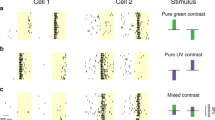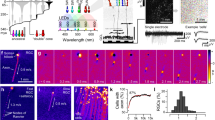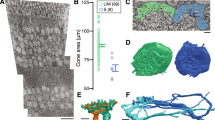Abstract
The brain computes visual colour by analysing the relative excitations of three types of retinal cones1. Each cone excitation is governed by a spectral sensitivity function which relates the amplitude of the neural response to wavelength at constant light intensity. The spectral sensitivities of human cones are not well characterized. We report measuring the sensitivities by recording electrical responses of human cones to stimuli of different wavelengths. Spectral sensitivities of 'green' and 'red' cones, determined over the entire visible region, show peaks near 530 and 560 nm respectively, and are remarkably similar to those of the old-world monkey Macaco fascicularis 2,3. They satisfactorily predict the photopic luminosity function, a measure of the sensitivity of cone-mediated human vision to light of different wavelengths. The kinetics of the light responses of human cones also appeared similar to those of macaque cones: the time to peak response to a dim flash was 50–100 ms and there was a characteristic undershoot during recovery.
This is a preview of subscription content, access via your institution
Access options
Subscribe to this journal
Receive 51 print issues and online access
$199.00 per year
only $3.90 per issue
Buy this article
- Purchase on Springer Link
- Instant access to full article PDF
Prices may be subject to local taxes which are calculated during checkout
Similar content being viewed by others
References
Boynton, R. M. Human Color Vision (Holt, Rinehart & Winston, New York, 1979).
Nunn, B. J., Schnapf, J. L. & Baylor, D. A. Nature 309, 264–266 (1984).
Baylor, D. A., Nunn, B. J. & Schnapf, J. L. J. Physiol. Lond. (in the press).
Baylor, D. A., Nunn, B. J. & Schnapf, J. L. J. Physiol. Lond. 357, 575–607 (1984).
Baylor, D. A., Lamb, T. D. & Yau, K.-W. J. Physiol Lond. 288, 589–611 (1979).
Naka, K. I. & Rushton, W. A. H. J. Physiol. Lond. 185, 536–555 (1966).
Lamb, T. D., McNaughton, P. A. & Yau, K.-W. J. Physiol. Lond. 319, 463–496 (1981).
Dartnall, H. J. A., Bowmaker, J. K. & Mollon, J. D. Proc. R. Soc. B220, 115–130 (1983).
Brindley, G. S. J. Physiol. Lond. 130, 35–44 (1955).
Goodeve, C. F. Proc. R. Soc. A155, 664–683 (1936).
Griffin, D. R., Hubbard, R. & Wald, G. J. opt. Soc. Am. 37, 546–554 (1947).
Smith, V. C. & Pokorny, J. Vision Res. 15, 161–171 (1975).
Wyszecki, G. & Stiles, W. S. (eds) Color Science (Wiley, New York, 1982).
Judd, D. B. CIE Proc. 1, 11 (1951).
Vos, J. J. Col. Res. Appl. 3, 125 (1978).
Nathans, J., Thomas, D. & Hogness, D. S. Science 232, 193–202 (1986).
Author information
Authors and Affiliations
Rights and permissions
About this article
Cite this article
Schnapf, J., Kraft, T. & Baylor, D. Spectral sensitivity of human cone photoreceptors. Nature 325, 439–441 (1987). https://doi.org/10.1038/325439a0
Received:
Accepted:
Issue Date:
DOI: https://doi.org/10.1038/325439a0
This article is cited by
-
Brain activity characteristics of RGB stimulus: an EEG study
Scientific Reports (2023)
-
Analysis of dim-light responses in rod and cone photoreceptors with altered calcium kinetics
Journal of Mathematical Biology (2023)
-
Machine learning for comprehensive prediction of high risk for Alzheimer’s disease based on chromatic pupilloperimetry
Scientific Reports (2022)
-
Revival of light signalling in the postmortem mouse and human retina
Nature (2022)
-
Digital postprocessing and image segmentation for objective analysis of colorimetric reactions
Nature Protocols (2021)
Comments
By submitting a comment you agree to abide by our Terms and Community Guidelines. If you find something abusive or that does not comply with our terms or guidelines please flag it as inappropriate.



